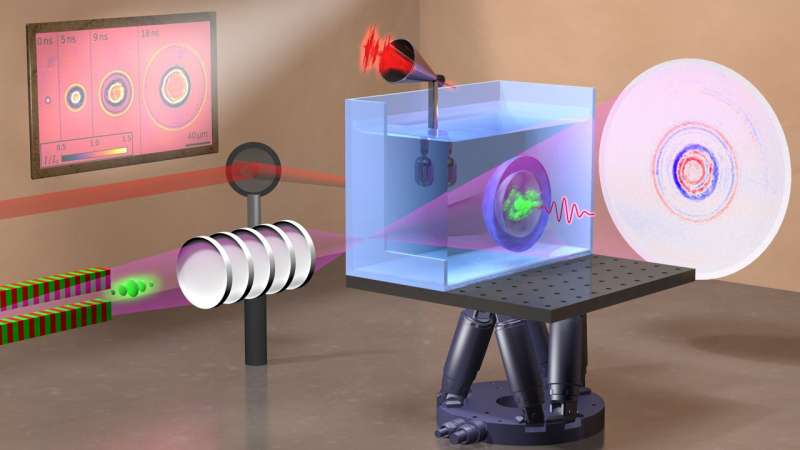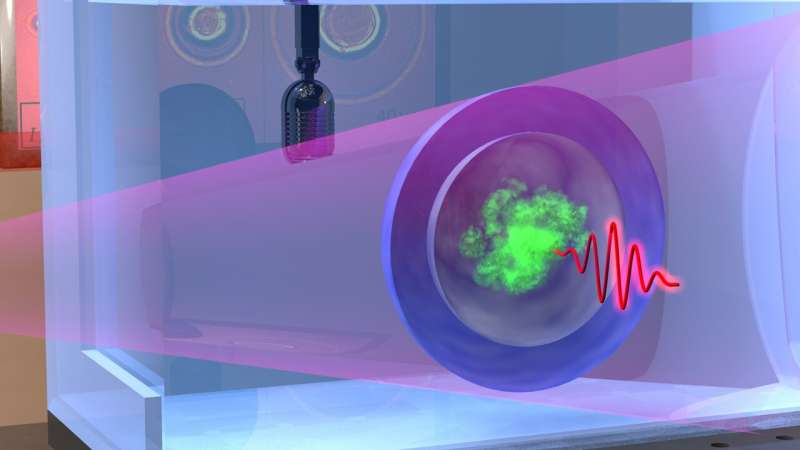X-ray flash imaging of laser-induced bubbles and shockwaves in water

Researchers have created tiny bubbles in high-pressure water via intense focused lasers. Under these conditions, the bubbles expand at supersonic speed and push a shockwave consisting of a spherical shell of highly compressed water. The research team led by the University of Göttingen, together with the Deutsches Elektronen-Synchroton (DESY) and the European X-Ray Free-Electron Laser (European XFEL) used an innovative technique involving holographic flash imaging and nanofocused X-ray laser pulses. The research was published in Nature Communications.
The team first created tiny bubbles with a radius of a few thousandths of a millimeter by focusing an infrared laser pulse in water to create cavitation, a phenomenon in which small vapor-filled cavities, i.e., bubbles, form in a liquid. The researchers observed the expanding bubble with synchronized but carefully controlled delayed X-ray pulses.
"In contrast to visible light, where refraction and scattering blur the image, X-ray imaging not only resolves the shape but also the density profile of the interior of both the bubble and the shockwave," explains Malte Vassholz, Ph.D. student at the University of Göttingen and lead author of the publication. "This enabled us to generate X-ray holograms of the tiny bubbles and record a large data stream with thousands of events, which we then analyzed by a specially devised 'decoding algorithm' to obtain the density of the gas in the bubble and the shockwave around it." Thanks to the well-controlled time delay between the seeding laser pulse that created the effect and the X-ray pulse that measured it, the team could then record a movie of the process.
The results of his experiment already challenge current scientific understanding and will help other scientists develop better models. Professor Tim Salditt, Professor of X-Ray Physics at the University of Göttingen, explains, "Even though water is the most important liquid on Earth, there is still much to learn about this mysterious and elusive substance. Thanks to the unique properties of the X-ray laser radiation generated at the European XFEL, and our new single-shot holography method, we can now observe what really goes on in vapor and liquid water under extreme conditions."
This research technique provides insights for processes relevant in other applications: "Cavitation can be an undesirable effect in fluids in pumps or propellers for instance, but it can be harnessed for use in laser processing of materials or to modify chemical reactions," explains Dr. Robert Mettin, an expert researching cavitation for many years at the Faculty of Physics, Göttingen University.
"In laser surgery, shockwaves and compressed gases in tiny bubbles are created intentionally in tissue, by laser pulses," adds Salditt. "In the future, such processes could be 'filmed' in detail, using the methodology which we have developed, at a microscopic level and at high temporal resolution."

More information: M. Vassholz et al, Pump-probe X-ray holographic imaging of laser-induced cavitation bubbles with femtosecond FEL pulses, Nature Communications (2021). DOI: 10.1038/s41467-021-23664-1
Provided by University of Göttingen




















